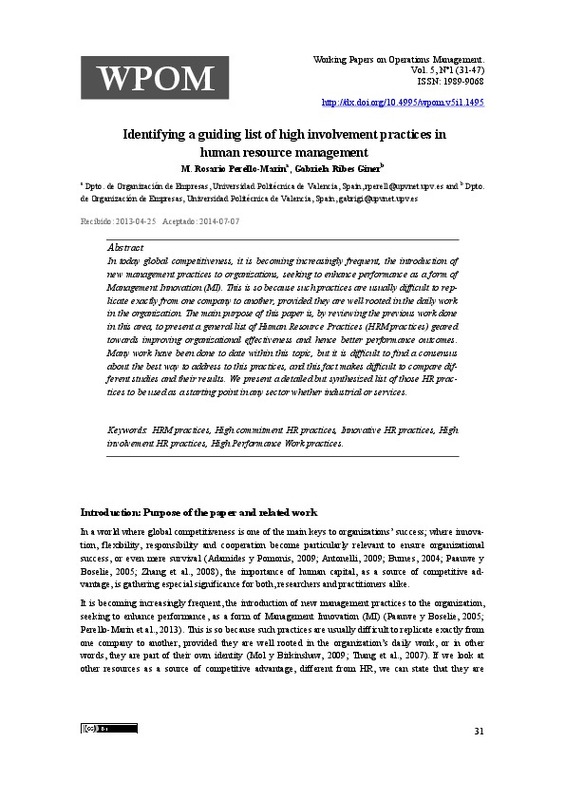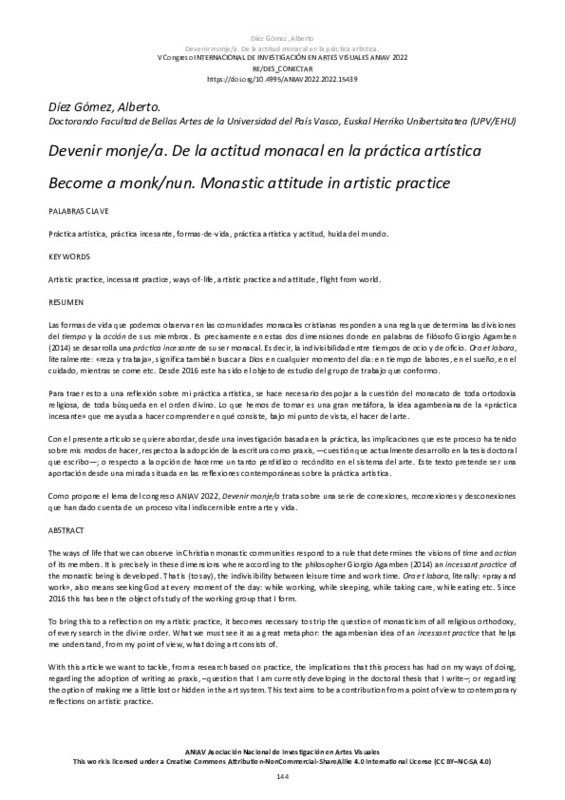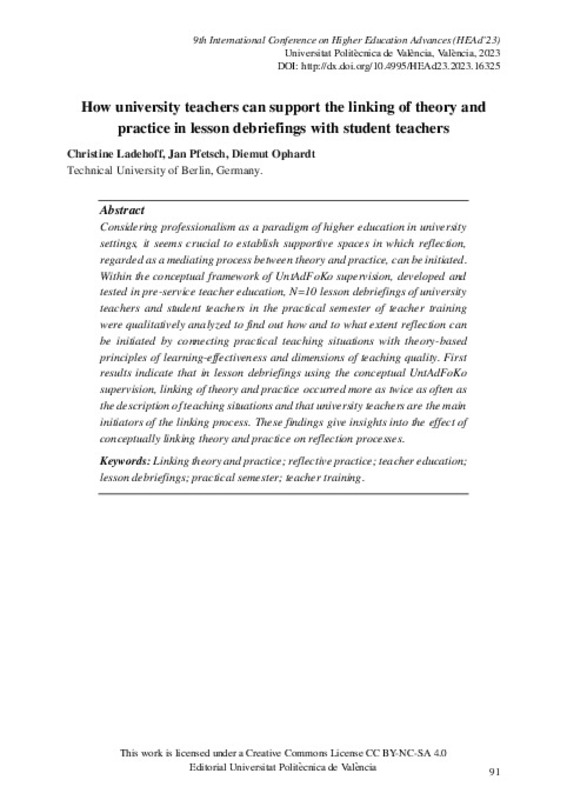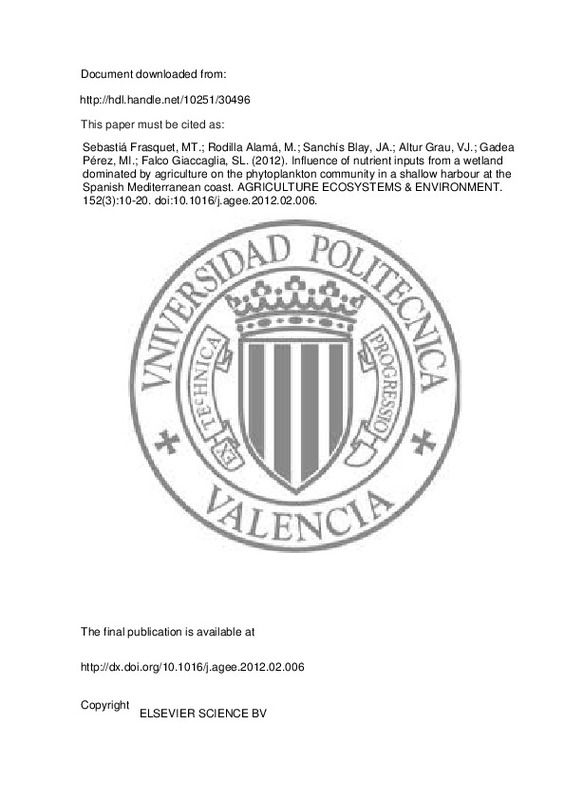JavaScript is disabled for your browser. Some features of this site may not work without it.
Buscar en RiuNet
Listar
Mi cuenta
Estadísticas
Ayuda RiuNet
Admin. UPV
Identifying a guiding list of high involvement practices in human resource management
Mostrar el registro sencillo del ítem
Ficheros en el ítem
| dc.contributor.author | Perelló Marín, María Rosario
|
es_ES |
| dc.contributor.author | Ribes Giner, Gabriela
|
es_ES |
| dc.date.accessioned | 2014-12-01T13:11:07Z | |
| dc.date.available | 2014-12-01T13:11:07Z | |
| dc.date.issued | 2014-06-30 | |
| dc.identifier.uri | http://hdl.handle.net/10251/45028 | |
| dc.description.abstract | [EN] In today global competitiveness, it is becoming increasingly frequent, the introduction of new management practices to organizations, seeking to enhance performance as a form of Management Innovation (MI). This is so because such practices are usually difficult to replicate exactly from one company to another, provided they are well rooted in the daily work in the organization. The main purpose of this paper is, by reviewing the previous work done in this area, to present a general list of Human Resource Practices (HRM practices) geared towards improving organizational effectiveness and hence better performance outcomes. Many work has been done to date within this topic, but it is difficult to find a consensus about the best way to address to this practices, and this fact makes difficult to compare different studies and their results. We present a detailed but synthesized list of those HR practices to be used as a starting point in any sector whether industrial or services | es_ES |
| dc.language | Inglés | es_ES |
| dc.publisher | Editorial Universitat Politècnica de València | |
| dc.relation.ispartof | Working Papers on Operations Management | |
| dc.rights | Reserva de todos los derechos | es_ES |
| dc.subject | HRM practices | es_ES |
| dc.subject | High commitment HR practices | es_ES |
| dc.subject | Innovative HR practices | es_ES |
| dc.subject | High involvement HR practices | es_ES |
| dc.title | Identifying a guiding list of high involvement practices in human resource management | es_ES |
| dc.type | Artículo | es_ES |
| dc.date.updated | 2014-11-27T11:16:42Z | |
| dc.identifier.doi | 10.4995/wpom.v5i1.1495 | |
| dc.rights.accessRights | Abierto | es_ES |
| dc.contributor.affiliation | Universitat Politècnica de València. Facultad de Administración y Dirección de Empresas - Facultat d'Administració i Direcció d'Empreses | es_ES |
| dc.contributor.affiliation | Universitat Politècnica de València. Departamento de Organización de Empresas - Departament d'Organització d'Empreses | es_ES |
| dc.description.bibliographicCitation | Perelló Marín, MR.; Ribes Giner, G. (2014). Identifying a guiding list of high involvement practices in human resource management. Working Papers on Operations Management. 5(1):31-47. https://doi.org/10.4995/wpom.v5i1.1495 | es_ES |
| dc.description.accrualMethod | SWORD | es_ES |
| dc.relation.publisherversion | https://doi.org/10.4995/wpom.v5i1.1495 | es_ES |
| dc.description.upvformatpinicio | 31 | es_ES |
| dc.description.upvformatpfin | 47 | es_ES |
| dc.type.version | info:eu-repo/semantics/publishedVersion | es_ES |
| dc.description.volume | 5 | |
| dc.description.issue | 1 | |
| dc.identifier.eissn | 1989-9068 | |
| dc.description.references | Adamides, E. D., & Pomonis, N. (2009). The co-evolution of product, production and supply chain decisions, and the emergence of manufacturing strategy. International Journal of Production Economics, 121(2), 301-312. doi:10.1016/j.ijpe.2006.11.025 | es_ES |
| dc.description.references | Ahmad, S., & Schroeder, R. G. (2002). The impact of human resource management practices on operational performance: recognizing country and industry differences. Journal of Operations Management, 21(1), 19-43. doi:10.1016/s0272-6963(02)00056-6 | es_ES |
| dc.description.references | Alfes, K., Shantz, A. D., Truss, C., & Soane, E. C. (2013). The link between perceived human resource management practices, engagement and employee behaviour: a moderated mediation model. The International Journal of Human Resource Management, 24(2), 330-351. doi:10.1080/09585192.2012.679950 | es_ES |
| dc.description.references | Altinay, L., Altinay, E., & Gannon, J. (2008). Exploring the relationship between the human resource management practices and growth in small service firms. The Service Industries Journal, 28(7), 919-937. doi:10.1080/02642060701846804 | es_ES |
| dc.description.references | Anand, G., & Kodali, R. (2008). Selection of lean manufacturing systems using the PROMETHEE. Journal of Modelling in Management, 3(1), 40-70. doi:10.1108/17465660810860372 | es_ES |
| dc.description.references | Antonelli, C. (2009). The economics of innovation: from the classical legacies to the economics of complexity. Economics of Innovation and New Technology, 18(7), 611-646. doi:10.1080/10438590802564543 | es_ES |
| dc.description.references | Arthur, J. B. (1994). EFFECTS OF HUMAN RESOURCE SYSTEMS ON MANUFACTURING PERFORMANCE AND TURNOVER. Academy of Management Journal, 37(3), 670-687. doi:10.2307/256705 | es_ES |
| dc.description.references | Arthur, J. B., & Boyles, T. (2007). Validating the human resource system structure: A levels-based strategic HRM approach. Human Resource Management Review, 17(1), 77-92. doi:10.1016/j.hrmr.2007.02.001 | es_ES |
| dc.description.references | Avella, L., Fernández, E., & Vázquez, C. J. (2001). Analysis of manufacturing strategy as an explanatory factor of competitiveness in the large Spanish industrial firm. International Journal of Production Economics, 72(2), 139-157. doi:10.1016/s0925-5273(00)00099-2 | es_ES |
| dc.description.references | Barrett, R., & Mayson, S. (2007). Human resource management in growing small firms. Journal of Small Business and Enterprise Development, 14(2), 307-320. doi:10.1108/14626000710746727 | es_ES |
| dc.description.references | Bayo Moriones, A.; Merino Díaz de Cerio, J. (2002). Las prácticas de recursos humanos de alto compromiso: un estudio de los factores que influyen sobre su adopción en la industria espa-ola. Cuadernos de Economía y Dirección de la Empresa nº. 12, pp. 227-247. | es_ES |
| dc.description.references | Bayo‐Moriones, A., Bello‐Pintado, A., & Merino‐Díaz‐de‐Cerio, J. (2008). The role of organizational context and infrastructure practices in JIT implementation. International Journal of Operations & Production Management, 28(11), 1042-1066. doi:10.1108/01443570810910188 | es_ES |
| dc.description.references | BECKER, B., & GERHART, B. (1996). THE IMPACT OF HUMAN RESOURCE MANAGEMENT ON ORGANIZATIONAL PERFORMANCE: PROGRESS AND PROSPECTS. Academy of Management Journal, 39(4), 779-801. doi:10.2307/256712 | es_ES |
| dc.description.references | Benson, G. S., Young, S. M., & Lawler III, E. E. (2006). High-involvement work practices and analysts’ forecasts of corporate earnings. Human Resource Management, 45(4), 519-537. doi:10.1002/hrm.20130 | es_ES |
| dc.description.references | Boselie, P., Dietz, G., & Boon, C. (2005). Commonalities and contradictions in HRM and performance research. Human Resource Management Journal, 15(3), 67-94. doi:10.1111/j.1748-8583.2005.tb00154.x | es_ES |
| dc.description.references | Bowen, D. E.; Ostroff, C. (2004). Understanding HRN–firm performance linkages: the role of the "strength" of the HRM system. Academy of Management Review, Vol. 29, nº. 2, pp. 203-221. | es_ES |
| dc.description.references | Burnes *, B. (2004). Kurt Lewin and complexity theories: back to the future? Journal of Change Management, 4(4), 309-325. doi:10.1080/1469701042000303811 | es_ES |
| dc.description.references | Camelo, C., Martín, F., Romero, P. M., & Valle, R. (2004). Human resources management in Spain: is it possible to speak of a typical model? The International Journal of Human Resource Management, 15(6), 935-958. doi:10.1080/09585190410001677250 | es_ES |
| dc.description.references | Chang, S., Gong, Y., & Shum, C. (2011). Promoting innovation in hospitality companies through human resource management practices. International Journal of Hospitality Management, 30(4), 812-818. doi:10.1016/j.ijhm.2011.01.001 | es_ES |
| dc.description.references | Cho, S., Woods, R. H., (Shawn) Jang, S., & Erdem, M. (2006). Measuring the impact of human resource management practices on hospitality firms’ performances. International Journal of Hospitality Management, 25(2), 262-277. doi:10.1016/j.ijhm.2005.04.001 | es_ES |
| dc.description.references | COLLINS, C. J., & CLARK, K. D. (2003). STRATEGIC HUMAN RESOURCE PRACTICES, TOP MANAGEMENT TEAM SOCIAL NETWORKS, AND FIRM PERFORMANCE: THE ROLE OF HUMAN RESOURCE PRACTICES IN CREATING ORGANIZATIONAL COMPETITIVE ADVANTAGE. Academy of Management Journal, 46(6), 740-751. doi:10.2307/30040665 | es_ES |
| dc.description.references | Collins, C. J., & Smith, K. G. (2006). Knowledge Exchange and Combination: The Role of Human Resource Practices in the Performance of High-Technology Firms. Academy of Management Journal, 49(3), 544-560. doi:10.5465/amj.2006.21794671 | es_ES |
| dc.description.references | COMBS, J., LIU, Y., HALL, A., & KETCHEN, D. (2006). HOW MUCH DO HIGH-PERFORMANCE WORK PRACTICES MATTER? A META-ANALYSIS OF THEIR EFFECTS ON ORGANIZATIONAL PERFORMANCE. Personnel Psychology, 59(3), 501-528. doi:10.1111/j.1744-6570.2006.00045.x | es_ES |
| dc.description.references | Cox, A., Zagelmeyer, S., & Marchington, M. (2006). Embedding employee involvement and participation at work. Human Resource Management Journal, 16(3), 250-267. doi:10.1111/j.1748-8583.2006.00017.x | es_ES |
| dc.description.references | Datta, D. K., Guthrie, J. P., & Wright, P. M. (2005). Human Resource Management and Labor Productivity: Does Industry Matter? Academy of Management Journal, 48(1), 135-145. doi:10.5465/amj.2005.15993158 | es_ES |
| dc.description.references | DELERY, J. E., & DOTY, D. H. (1996). MODES OF THEORIZING IN STRATEGIC HUMAN RESOURCE MANAGEMENT: TESTS OF UNIVERSALISTIC, CONTINGENCY, AND CONFIGURATIONS. PERFORMANCE PREDICTIONS. Academy of Management Journal, 39(4), 802-835. doi:10.2307/256713 | es_ES |
| dc.description.references | Dewettinck, K., & Remue, J. (2011). Contextualizing HRM in comparative research: The role of the Cranet network. Human Resource Management Review, 21(1), 37-49. doi:10.1016/j.hrmr.2010.09.010 | es_ES |
| dc.description.references | Dos Santos Moreira, P. M. (2008). Characterising human resources management practices in Portugal: an empirical analysis. The International Journal of Human Resource Management, 19(10), 1864-1880. doi:10.1080/09585190802324031 | es_ES |
| dc.description.references | Drummond, I., & Stone, I. (2007). Exploring the potential of high performance work systems in SMEs. Employee Relations, 29(2), 192-207. doi:10.1108/01425450710720011 | es_ES |
| dc.description.references | García-Lorenzo, A., & Prado, J. C. (2003). Employee participation systems in Spain. Past, present and future. Total Quality Management & Business Excellence, 14(1), 15-24. doi:10.1080/14783360309704 | es_ES |
| dc.description.references | Gooderham, P., Parry, E., & Ringdal, K. (2008). The impact of bundles of strategic human resource management practices on the performance of European firms. The International Journal of Human Resource Management, 19(11), 2041-2056. doi:10.1080/09585190802404296 | es_ES |
| dc.description.references | Guchait, P., & Cho, S. (2010). The impact of human resource management practices on intention to leave of employees in the service industry in India: the mediating role of organizational commitment. The International Journal of Human Resource Management, 21(8), 1228-1247. doi:10.1080/09585192.2010.483845 | es_ES |
| dc.description.references | Guerrero, S., & Barraud-Didier, V. (2004). High-involvement practices and performance of French firms. The International Journal of Human Resource Management, 15(8), 1408-1423. doi:10.1080/0958519042000258002 | es_ES |
| dc.description.references | Guest, D., Conway, N., & Dewe, P. (2004). Using sequential tree analysis to search for «bundles» of HR practices. Human Resource Management Journal, 14(1), 79-96. doi:10.1111/j.1748-8583.2004.tb00113.x | es_ES |
| dc.description.references | Guest, D. E. (2011). Human resource management and performance: still searching for some answers. Human Resource Management Journal, 21(1), 3-13. doi:10.1111/j.1748-8583.2010.00164.x | es_ES |
| dc.description.references | Guest, D. E., Michie, J., Conway, N., & Sheehan, M. (2003). Human Resource Management and Corporate Performance in the UK. British Journal of Industrial Relations, 41(2), 291-314. doi:10.1111/1467-8543.00273 | es_ES |
| dc.description.references | Guthrie, J. P., Spell, C. S., & Nyamori, R. O. (2002). Correlates and consequences of high involvement work practices: the role of competitive strategy. The International Journal of Human Resource Management, 13(1), 183-197. doi:10.1080/09585190110085071 | es_ES |
| dc.description.references | Hislop, D. (2003). Linking human resource management and knowledge management via commitment. Employee Relations, 25(2), 182-202. doi:10.1108/01425450310456479 | es_ES |
| dc.description.references | HUSELID, M. A. (1995). THE IMPACT OF HUMAN RESOURCE MANAGEMENT PRACTICES ON TURNOVER, PRODUCTIVITY, AND CORPORATE FINANCIAL PERFORMANCE. Academy of Management Journal, 38(3), 635-672. doi:10.2307/256741 | es_ES |
| dc.description.references | Huselid, M. A. (2011). Celebrating 50 Years: Looking back and looking forward: 50 years of Human Resource Management. Human Resource Management, 50(3), 309-312. doi:10.1002/hrm.20425 | es_ES |
| dc.description.references | Ichniowski, C., & Shaw, K. (1999). The Effects of Human Resource Management Systems on Economic Performance: An International Comparison of U.S. and Japanese Plants. Management Science, 45(5), 704-721. doi:10.1287/mnsc.45.5.704 | es_ES |
| dc.description.references | Lawler III, E. E.; Mohrman, S. A.; Ledford, G. E. (1995). Creating high performance organizations: practices and results of employee involvement and total quality management in Fortune 1000 companies. Jossey-Bass. | es_ES |
| dc.description.references | Macduffie, J. P. (1995). Human Resource Bundles and Manufacturing Performance: Organizational Logic and Flexible Production Systems in the World Auto Industry. ILR Review, 48(2), 197-221. doi:10.1177/001979399504800201 | es_ES |
| dc.description.references | Marchington, M., & Grugulis, I. (2000). «Best practice» human resource management: perfect opportunity or dangerous illusion? The International Journal of Human Resource Management, 11(6), 1104-1124. doi:10.1080/09585190050177184 | es_ES |
| dc.description.references | Marin-Garcia, J. A., Miralles, C., Garcia-Sabater, J. J., & Perello-Marin, M. R. (2011). Alternative tools to mass production and human performance indicators in sheltered work centers of Valencian community (Spain). Journal of Industrial Engineering and Management, 4(3). doi:10.3926/jiem.2011.v4n3.p467-480 | es_ES |
| dc.description.references | McClean, E., & Collins, C. J. (2011). High-commitment HR practices, employee effort, and firm performance: Investigating the effects of HR practices across employee groups within professional services firms. Human Resource Management, 50(3), 341-363. doi:10.1002/hrm.20429 | es_ES |
| dc.description.references | González, S. M., & Tacorante, D. V. (2004). A new approach to the best practices debate: are best practices applied to all employees in the same way? The International Journal of Human Resource Management, 15(1), 56-75. doi:10.1080/098519032000157339 | es_ES |
| dc.description.references | Mol, M. J., & Birkinshaw, J. (2009). The sources of management innovation: When firms introduce new management practices. Journal of Business Research, 62(12), 1269-1280. doi:10.1016/j.jbusres.2009.01.001 | es_ES |
| dc.description.references | Ordiz Fuertes, M. (2002). Prácticas de alto rendimiento en recursos humanos. Concepto y factores que motivan su adopcion. Cuadernos de economia y direccion de empresa, Vol. 12, pp. 247-265. | es_ES |
| dc.description.references | Paauwe, J., & Boselie, P. (2005). ‘Best practices … in spite of performance’: just a matter of imitation? The International Journal of Human Resource Management, 16(6), 987-1003. doi:10.1080/09585190500120798 | es_ES |
| dc.description.references | Pereira, C. M. M., & Gomes, J. F. S. (2012). The strength of human resource practices and transformational leadership: impact on organisational performance. The International Journal of Human Resource Management, 23(20), 4301-4318. doi:10.1080/09585192.2012.667434 | es_ES |
| dc.description.references | Perello-Marin, M. R.; Marin-Garcia J A; Marcos-Cuevas J (2013). Can we study management innovation from the lens of complexity? Path dependence approach. Management Decision, Vol. In press. | es_ES |
| dc.description.references | Petter, S.; Straub, D.; Rai, A. (2007). Specifying formative constructs in information systems research. Mis Quarterly, Vol. 31, nº. 4, pp. 623-656. | es_ES |
| dc.description.references | Prieto, I. M., & Pilar Pérez Santana, M. (2012). Building ambidexterity: The role of human resource practices in the performance of firms from Spain. Human Resource Management, 51(2), 189-211. doi:10.1002/hrm.21463 | es_ES |
| dc.description.references | Roos, G., Fernström, L., & Pike, S. (2004). Human resource management and business performance measurement. Measuring Business Excellence, 8(1), 28-37. doi:10.1108/13683040410524711 | es_ES |
| dc.description.references | Stavrou, E. T., Brewster, C., & Charalambous, C. (2010). Human resource management and firm performance in Europe through the lens of business systems: best fit, best practice or both? The International Journal of Human Resource Management, 21(7), 933-962. doi:10.1080/09585191003783371 | es_ES |
| dc.description.references | Tang, T.-W., & Tang, Y.-Y. (2012). Promoting service-oriented organizational citizenship behaviors in hotels: The role of high-performance human resource practices and organizational social climates. International Journal of Hospitality Management, 31(3), 885-895. doi:10.1016/j.ijhm.2011.10.007 | es_ES |
| dc.description.references | Tarí, J. J., Molina, J. F., & Castejón, J. L. (2007). The relationship between quality management practices and their effects on quality outcomes. European Journal of Operational Research, 183(2), 483-501. doi:10.1016/j.ejor.2006.10.016 | es_ES |
| dc.description.references | Thang, L. C., Rowley, C., Quang, T., & Warner, M. (2007). To what extent can management practices be transferred between countries? Journal of World Business, 42(1), 113-127. doi:10.1016/j.jwb.2006.11.005 | es_ES |
| dc.description.references | De Waal, A. A. (2007). The characteristics of a high performance organization. Business Strategy Series, 8(3), 179-185. doi:10.1108/17515630710684178 | es_ES |
| dc.description.references | Wood, S., & de Menezes, L. M. (2008). Comparing perspectives on high involvement management and organizational performance across the British economy. The International Journal of Human Resource Management, 19(4), 639-683. doi:10.1080/09585190801953673 | es_ES |
| dc.description.references | Wood, S., Van Veldhoven, M., Croon, M., & de Menezes, L. M. (2012). Enriched job design, high involvement management and organizational performance: The mediating roles of job satisfaction and well-being. Human Relations, 65(4), 419-445. doi:10.1177/0018726711432476 | es_ES |
| dc.description.references | Wood, S. J., & Wall, T. D. (2007). Work enrichment and employee voice in human resource management-performance studies. The International Journal of Human Resource Management, 18(7), 1335-1372. doi:10.1080/09585190701394150 | es_ES |
| dc.description.references | Wright, P. M., & McMahan, G. C. (1992). Theoretical Perspectives for Strategic Human Resource Management. Journal of Management, 18(2), 295-320. doi:10.1177/014920639201800205 | es_ES |
| dc.description.references | Zatzick, C. D., & Iverson, R. D. (2006). High-Involvement Management and Workforce Reduction: Competitive Advantage or Disadvantage? Academy of Management Journal, 49(5), 999-1015. doi:10.5465/amj.2006.22798180 | es_ES |
| dc.description.references | Zhang, Z., Wan, D., & Jia, M. (2008). Do high-performance human resource practices help corporate entrepreneurship? The mediating role of organizational citizenship behavior. The Journal of High Technology Management Research, 19(2), 128-138. doi:10.1016/j.hitech.2008.10.005 | es_ES |











